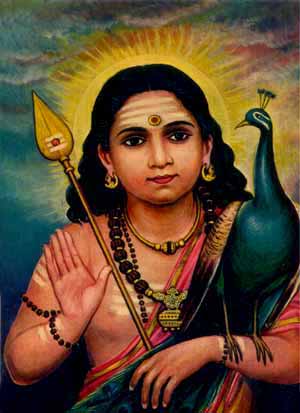|
| ||
 "Realize Murugan to eliminate misdeeds and obtain grace"
(Colombo: The Tinakkural of 1 July 2000)The glories of Kataragama Murugan are found in the ancient puranas and itihasas. Arunagirinathar of South India mentioned about Kataragama Murugan in fourteen of his famous Tiruppukal songs. The Skanda Purana and the Mahavamsa indicate that Lord Murugan of Kataragama fought against the asura-titans here. The shrine and its surroundings have become more of a tourist attraction than the real spiritual holy spot that prevailed from ancient times until only recently. The shrine is not only for Sri Lankans but also for South and North Indians. There is much evidence to prove this. Teyvanai Amman is especially highlighted in the book written in English by Dr. Mrs. Selvam Kalyanasundaram. The history of the Mathadipati and Trustee reveals the connections of Indians, especially the North Indians, with Kataragama. It is believed by Hindus that the pilgrimage to Kataragama is feasible only if God Kataragama gives some signal to invite them. On a long journey through jungles they face many challenges to win all by the grace of God. There are many articles about these pilgrims. It is the playful nature of the god to put his devotees in so many difficulties and finally shed grace upon them by fulfilling their vows. North Indian books mention about many saints who spent their spiritual life in Kataragama. These books are found in many Hindu religious missions and ashrams. The Mahavamsa also bears witness to this fact. The saint called ‘Kalyanagiri' came from North India and was performing his sannyasin life for twelve years chanting the Sadakshara Mantra without sleeping. Then he attained the samadhi stage. During his samadhi days, the Veddas (Wanniyal-aeto forest dwellers) paid respect to him and God Kataragama blessed them. The yantra (enchanted diagram etched on a copper plate) made by Kalyanagiri I is the one which is kept in a small casket and worshipped in Kataragama. The Lord in His nada bindu tattva (the form of letters and sounds enshrined in the yantra) is taken in procession on the back of an elephant tusker. The place where the saint was in tapas is the mulasthanam (sanctum sanctorum). Following the first Kalyanagiri Swami there were two other Kalyanagiri swamis who administered the temple. Muttulinga Swami samadhi (now Sivan Temple) is the samadhi of the Giri paramparas or lineages. Following them the Veddas – people of the jungle – worshiped the Lord. Then it went onto the kapuralas, the Sinhalese shaman-priests. They still follow the Vedda way of conducting pujas. They tie up their mouths with white cloth and do pujas. They offer fruit and honey from the jungle.
It is also said that when Vijaya was about to be killed by Kuveni, Lord Kataragama saved him. It is difficult to assess whether the present kapuralas are the descendants of Veddas or of Vijaya, or of both. However literature on Murugan reveals that naga-sarpa (snake) worship exixted in these parts around 230 BC. Sir Ponnambalam Arunachalam also mentioned in one of his books that Lord Murugan was worshipped by ancient Tamils in Sri Lanka. Some Sinhala books say that Rajasingha I built the Maha Devale, the moolasthanam of Kataragama. The vibhuti or holy ash is obtained by digging at a place called Vibhuti Malai or Santana Malai near Kathira Malai. Masanga, the brother of Devanampiyatissa, when defeated by South Indian kings, surrendered to God Kataragama and was saved. There were many attempts to alter the Maha Devale but Teyvani Amman Temple Trustee Dattaramagiri Swami fought against the attempts and saved the shrine. In 1898 Swami Kesopuri (Pal Kudi Bawa) in collaboration with Sir Ponnambalam Arunachalam administered the temple. This makes the relationship of the northern part of Sri Lanka with the Kataragama temple. There was a mixed family tree of Kalinga, Yaksha and Nagas. |
![Teyvanai Amman Matadhipati and devotees [12 kb]](../pix/teyvanai_kodiyetram2.jpg)